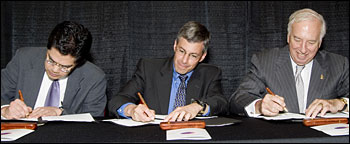
UMaryland, NIST and NSA Create Joint Quantum Institute
COLLEGE PARK, Md., Sept. 11, 2006 -- Officials from the University of Maryland, the Commerce Department’s National Institute of Standards and Technology (NIST) and the National Security Agency today announced the creation of a joint research institute designed to advance quantum physics research and make theoretical quantum technology a reality.
Signing a memorandum of understanding establishing the Joint Quantum Institute in a ceremony at the University of Maryland, College Park, today are (l-r) Frederick R. Chang (NSA), William Jeffrey (NIST), and UM President C.D. Mote Jr. (Photo: Thai Nguyen, University of Maryland)
A memorandum of understanding establishing the Joint Quantum Institute (JQI) was signed by University of Maryland (UM) President C.D. Mote Jr., NIST Director William Jeffrey and Frederick R. Chang, NSA research director. The institute will be located on the UM campus in College Park. It will have an annual budget of approximately $6 million and a staff of about 20 scientists, half from the university and half from NIST.
The staff will include experts in atomic physics, condensed matter and quantum information, including William D. Phillips, the 1997 Nobel laureate in physics, who is both a NIST Fellow and a UM Distinguished University Professor of Physics. Co-directors for the institute are Christopher J. Lobb, UM professor of physics, and Carl J. Williams, chief of the NIST Atomic Physics Div.
The three participating institutions have a shared history of collaboration and cooperation in education, research and public service. For UM and NIST, the new institute is the latest of several major new collaborative efforts initiated since the two institutions signed an agreement in 2003 to broadly expand research collaborations and professional linkages. Last year the two institutions created the UM-NIST Center for Nanomanufacturing and Metrology, a joint venture created to advance the science and technology of manufacturing products based on the unique properties achieved at the scale of a nanometer (one billionth of a meter).
The objectives of the new Joint Quantum Institute include developing it into a world-class research institute that will build the scientific foundation for understanding coherent quantum phenomena and lay the foundation for engineering and controlling complex quantum systems capable of using the coherence and entanglement of quantum mechanics. The collaboration between the three groups will also establish it as a unique, interdisciplinary center for the interchange of ideas among atomic physics, condensed matter and quantum information scientists.
In pursuing these objectives, the JQI is expected to train scientists and engineers for future industrial opportunities and provide US industry with cutting-edge research results. The JQI’s three primary scientific disciplines are: atomic, molecular and optical physics (such as ultracold atomic gases, matter-wave optics, quantum optics and optical lattices), a major area of expertise at NIST and a growing strength at UM; condensed matter physics (such as quantum dots and superconductivity), an area of expertise at UM and the NSA’s Laboratory for Physical Sciences; and quantum information science (such as quantum measurement theory, quantum computation and quantum communication), areas of expertise at both NIST and UM. The NSA is a long-standing supporter of and collaborator in research in these fields.
Among its benefits, the JQI is expected to leverage the combination of a government laboratory’s emphasis on developing practical metrology tools directed at national needs with an academic focus on scientific exploration. From NIST’s perspective, the new institute is modeled in part on JILA, a joint institute of NIST and the University of Colorado at Boulder. Since its founding in the 1960s, JILA has become one of the nation’s leading research institutes in the physical sciences, with a faculty that includes three Nobel laureates (two from NIST) and two MacArthur Fellows (one from NIST).
For more information, visit: www.maryland.edu or www.nist.gov
Published: September 2006